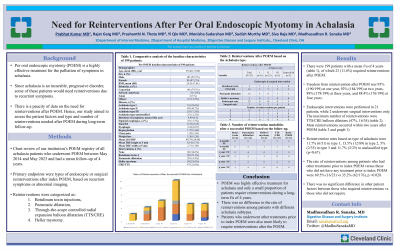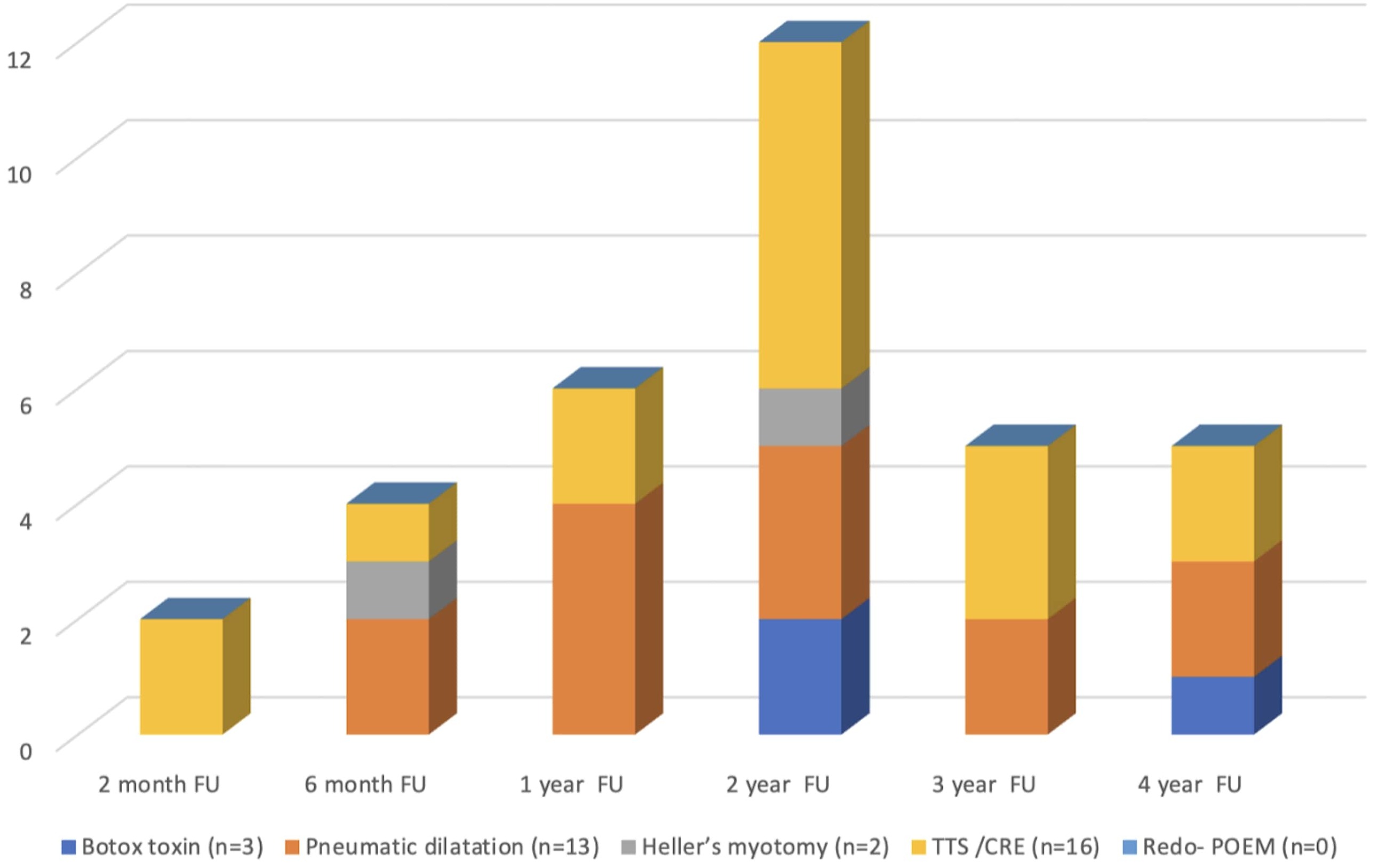Tuesday Poster Session
Category: Esophagus
P3247 - Need for Reinterventions After Per Oral Endoscopic Myotomy in Achalasia
Tuesday, October 24, 2023
10:30 AM - 4:00 PM PT
Location: Exhibit Hall

Has Audio
- PK
Prabhat Kumar, MD
Cleveland Clinic Foundation
Cleveland, OH
Presenting Author(s)
Prabhat Kumar, MD, Rajat Garg, MD, Prashanthi N. Thota, MD, Yi Qin, MD, Monisha Sudarshan, MD, Sudish Murthy, MD, Siva Raja, MD, Madhusudhan R.. Sanaka, MD
Cleveland Clinic Foundation, Cleveland, OH
Introduction: Per oral endoscopic myotomy (POEM) is a highly effective treatment for the palliation of symptoms in achalasia. Since achalasia is an incurable, progressive disorder, some of these patients would need reinterventions due to recurrent symptoms. There is a paucity of data on the need for reinterventions after POEM. Hence, our study aimed to assess the patient factors and type and number of reinterventions needed after POEM during long-term follow-up.
Methods: Chart review of our institution’s POEM registry of all achalasia patients who underwent POEM between May 2014 and May 2023 and had a mean follow-up of 4 years. Primary endpoints were types of endoscopic or surgical reinterventions after index POEM, based on recurrent symptoms or abnormal imaging. Reinterventions were categorized as (1) botulinum toxin injections, (2) pneumatic dilation, (3) through-the-scope controlled radial expansion balloon dilatation (TTS/CRE), and (4) Heller myotomy.
Results: There were 199 patients with a mean f/u of 4 years (table), of which 23 (11.6%) required reinterventions after POEM. Freedom from reintervention after POEM was 95% (190/199) at one year, 92% (184/199) at two years, 89% (178/199) at three years, and 88.4% (176/199) at four years. Endoscopic interventions were performed in 21 patients, while 2 underwent surgical interventions only. The maximum number of reinterventions were TTS/CRE balloon dilations (47%, 16/34). Most reinterventions occurred within two years after POEM (graph). Reintervention rates based on type of achalasia were 11.7% (6/51) in type 1, 13.5% (12/89) in type 2, 5% (2/35) in type 3 and 11.7% (2/25) in unclassified type (p=0.67). The rate of reinterventions among patients who had other treatments prior to index POEM versus those who did not have any treatment prior to index POEM were 69.5% (16/23) vs 35.2% (62/176), p =0.028. There was no significant difference in other patient factors between those who required reinterventions vs those who did not require.
Discussion: POEM was highly effective treatment for achalasia and only a small proportion of patients required reinterventions during a long-term f/u of 4 years. There was no difference in the rate reinterventions among patients with different achalasia subtypes. Interestingly, patients who underwent other treatments prior to index POEM were also more likely to require reinterventions after the POEM. Further studies are warranted to confirm these findings.

Disclosures:
Prabhat Kumar, MD, Rajat Garg, MD, Prashanthi N. Thota, MD, Yi Qin, MD, Monisha Sudarshan, MD, Sudish Murthy, MD, Siva Raja, MD, Madhusudhan R.. Sanaka, MD. P3247 - Need for Reinterventions After Per Oral Endoscopic Myotomy in Achalasia, ACG 2023 Annual Scientific Meeting Abstracts. Vancouver, BC, Canada: American College of Gastroenterology.
Cleveland Clinic Foundation, Cleveland, OH
Introduction: Per oral endoscopic myotomy (POEM) is a highly effective treatment for the palliation of symptoms in achalasia. Since achalasia is an incurable, progressive disorder, some of these patients would need reinterventions due to recurrent symptoms. There is a paucity of data on the need for reinterventions after POEM. Hence, our study aimed to assess the patient factors and type and number of reinterventions needed after POEM during long-term follow-up.
Methods: Chart review of our institution’s POEM registry of all achalasia patients who underwent POEM between May 2014 and May 2023 and had a mean follow-up of 4 years. Primary endpoints were types of endoscopic or surgical reinterventions after index POEM, based on recurrent symptoms or abnormal imaging. Reinterventions were categorized as (1) botulinum toxin injections, (2) pneumatic dilation, (3) through-the-scope controlled radial expansion balloon dilatation (TTS/CRE), and (4) Heller myotomy.
Results: There were 199 patients with a mean f/u of 4 years (table), of which 23 (11.6%) required reinterventions after POEM. Freedom from reintervention after POEM was 95% (190/199) at one year, 92% (184/199) at two years, 89% (178/199) at three years, and 88.4% (176/199) at four years. Endoscopic interventions were performed in 21 patients, while 2 underwent surgical interventions only. The maximum number of reinterventions were TTS/CRE balloon dilations (47%, 16/34). Most reinterventions occurred within two years after POEM (graph). Reintervention rates based on type of achalasia were 11.7% (6/51) in type 1, 13.5% (12/89) in type 2, 5% (2/35) in type 3 and 11.7% (2/25) in unclassified type (p=0.67). The rate of reinterventions among patients who had other treatments prior to index POEM versus those who did not have any treatment prior to index POEM were 69.5% (16/23) vs 35.2% (62/176), p =0.028. There was no significant difference in other patient factors between those who required reinterventions vs those who did not require.
Discussion: POEM was highly effective treatment for achalasia and only a small proportion of patients required reinterventions during a long-term f/u of 4 years. There was no difference in the rate reinterventions among patients with different achalasia subtypes. Interestingly, patients who underwent other treatments prior to index POEM were also more likely to require reinterventions after the POEM. Further studies are warranted to confirm these findings.

Figure: Rate of reintervention after successful POEM for achalasia.
Disclosures:
Prabhat Kumar indicated no relevant financial relationships.
Rajat Garg indicated no relevant financial relationships.
Prashanthi Thota indicated no relevant financial relationships.
Yi Qin indicated no relevant financial relationships.
Monisha Sudarshan indicated no relevant financial relationships.
Sudish Murthy indicated no relevant financial relationships.
Siva Raja indicated no relevant financial relationships.
Madhusudhan Sanaka indicated no relevant financial relationships.
Prabhat Kumar, MD, Rajat Garg, MD, Prashanthi N. Thota, MD, Yi Qin, MD, Monisha Sudarshan, MD, Sudish Murthy, MD, Siva Raja, MD, Madhusudhan R.. Sanaka, MD. P3247 - Need for Reinterventions After Per Oral Endoscopic Myotomy in Achalasia, ACG 2023 Annual Scientific Meeting Abstracts. Vancouver, BC, Canada: American College of Gastroenterology.
